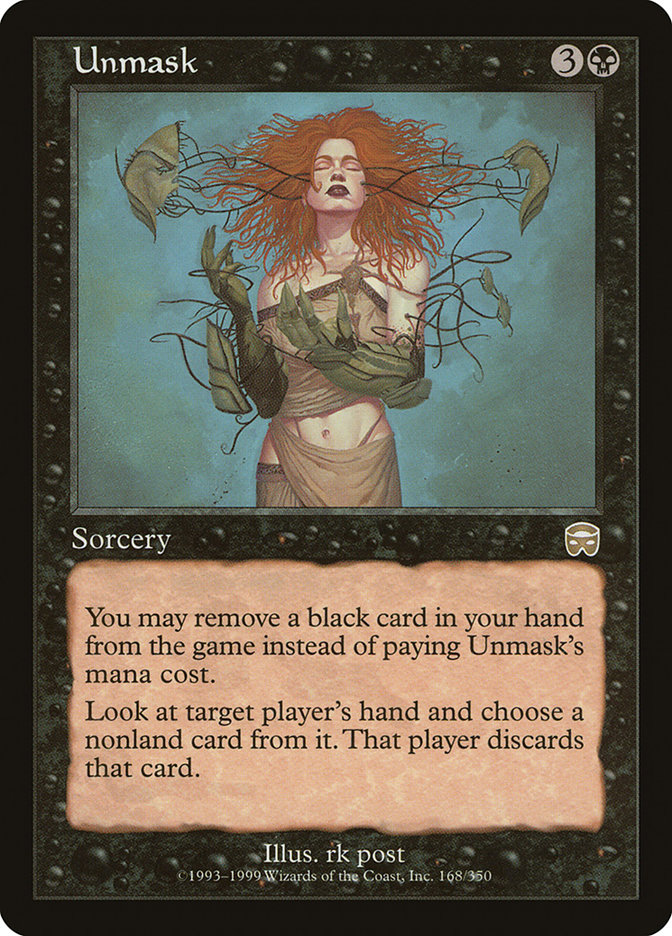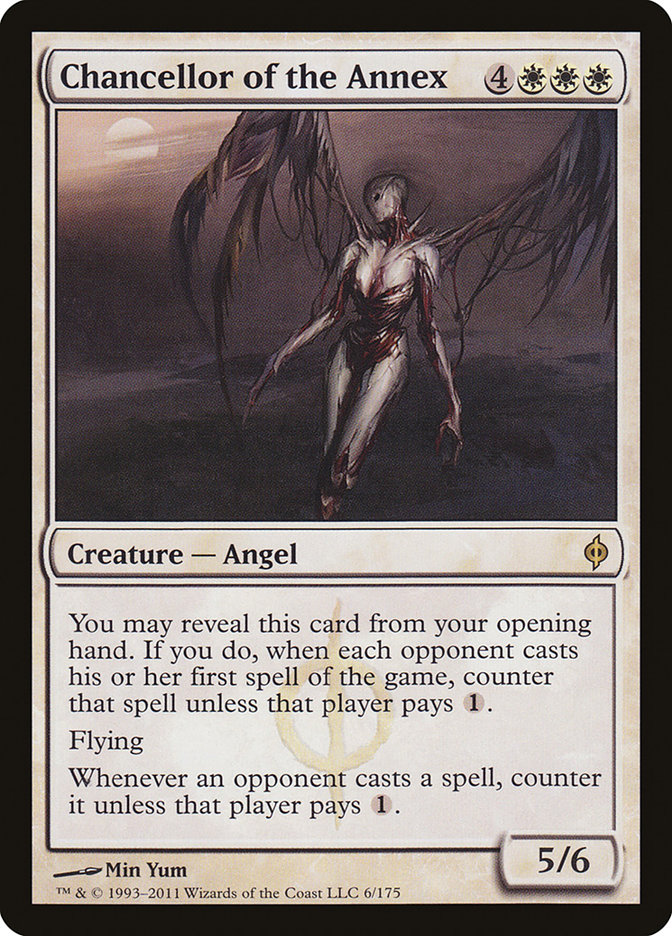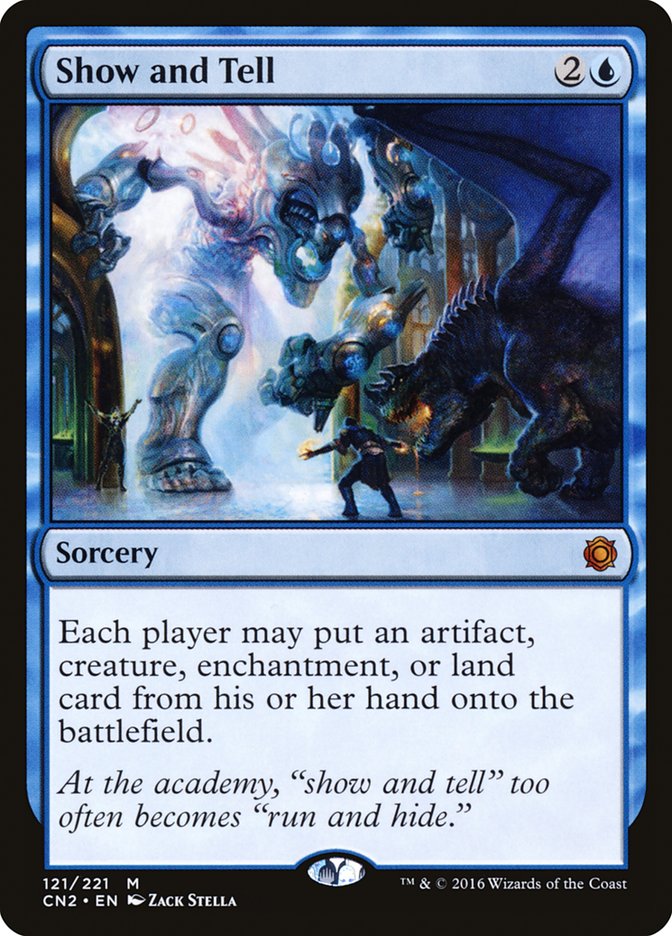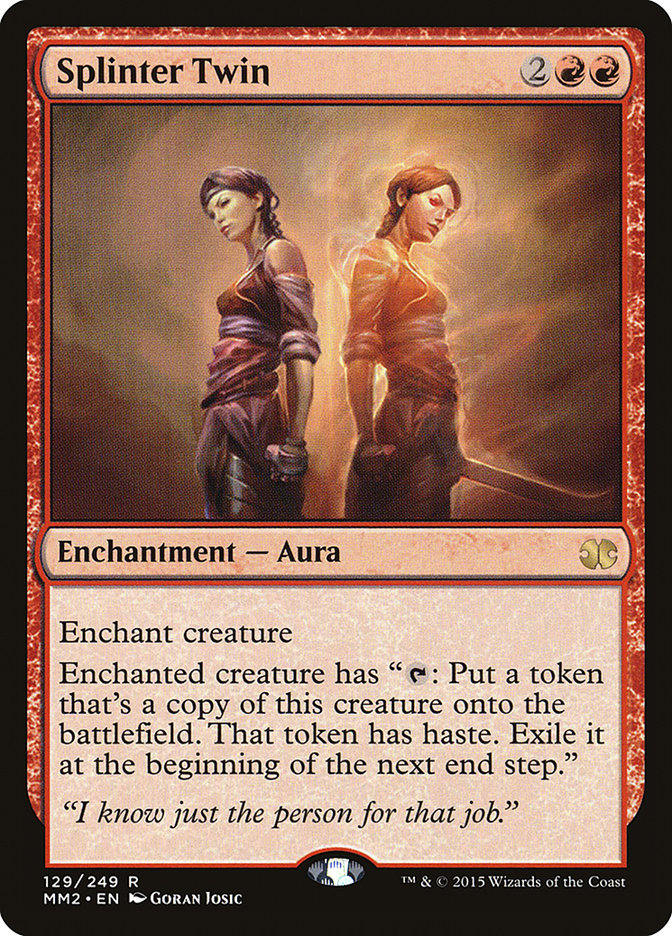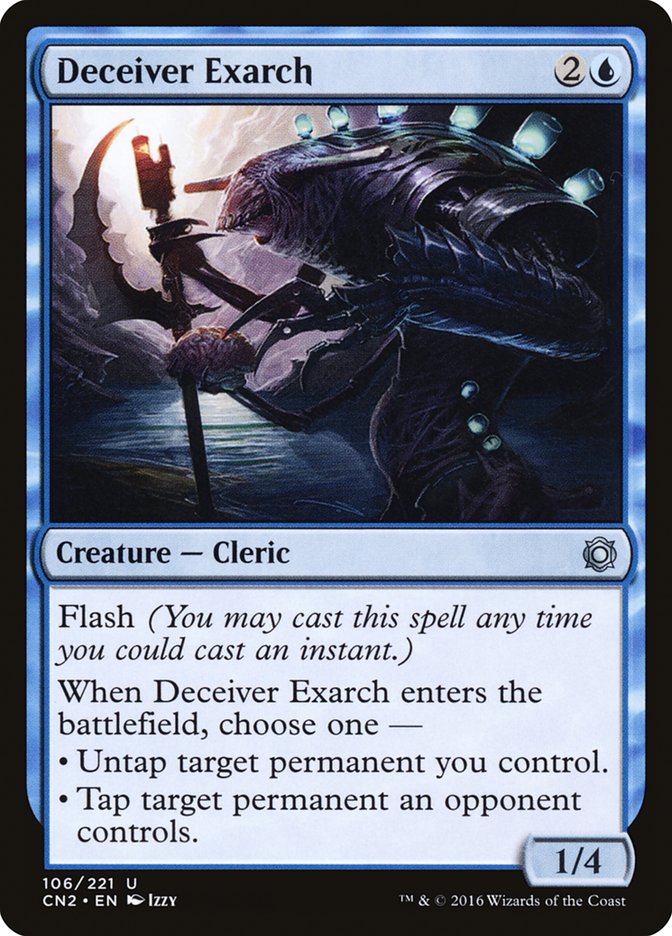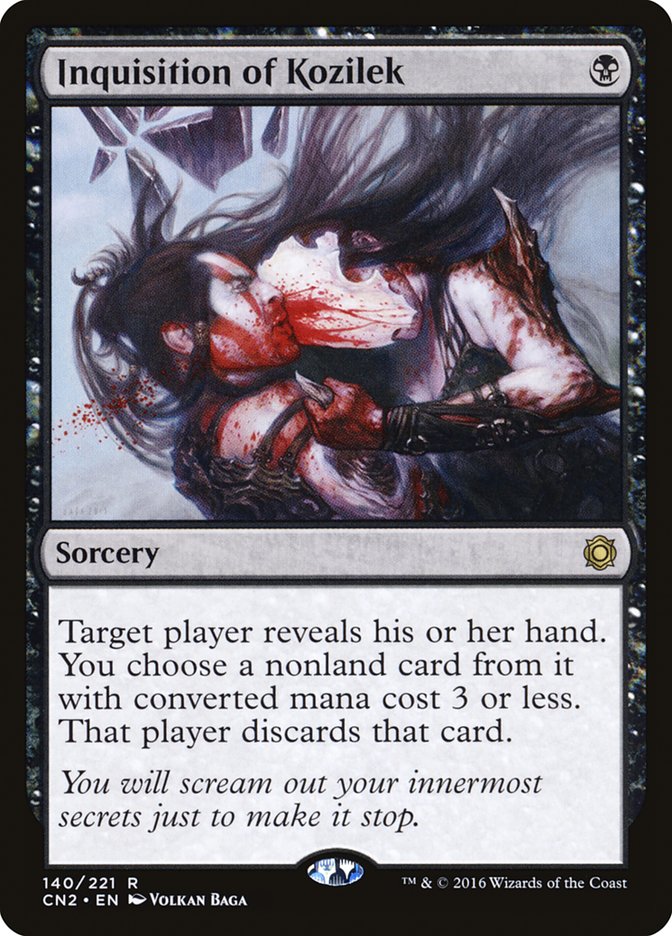This past weekend at #SCGBALT I had the pleasure of playing one of the most fun decks in my recent memory. The format: Legacy. The deck:
Creatures (11)
Lands (14)
Spells (35)

Long story short, this deck acts a lot like Goblin Charbelcher. Your entire goal is to be as fast as possible, using some of the most degenerate cards in Magic’s history to put a Griselbrand onto the battlefield on the first turn. Historically, this type of deck is known as a “glass cannon” combo deck. But unlike other glass cannon combo decks, this one has quite a few ways to disrupt the opponent while also being incredibly fast.
First off, let’s take a look at that disruption.
These three cards help buy you enough time to set up your combo and fight through disruption from the opposing player. A single Thoughtseize or Unmask can be enough to steal their Force of Will or anti-graveyard card, allowing you free rein when it comes to assembling your combo. The backside of these discard spells is that they also give you the ability to target yourself, acting as a graveyard enabler. I don’t even remember how many times during the tournament I used Unmask on myself to enable a first-turn monster, but I do know it happened a lot.
But Chancellor of the Annex plays two different roles as well. Slowing down your opponent’s first play is backbreaking when you are on the play. Stopping their Force of Will or Surgical Extraction when you’re on the play is a game-changer, but it is also a big threat that needs an immediate answer. The fact that four of your disruptive elements are also win conditions that make life hell for most opponents is a plus because it allows you to condense your deck a bit. Imagine if all of your creatures had similar abilities at the beginning of the game, each one giving you a virtual spell while also playing the role of combo piece!
And those two aspects of the deck, disruption adding to consistency of combo, drew me to the deck in the first place. How sweet it is to put a big creature onto the battlefield on the first turn with just Unmask (targeting yourself) and Reanimate? No fast mana required. Of course, doing so can put you at serious risk. Cards like Unmask have a serious cost, and burning a lot of resources to assemble a combo makes disruption from the opponent that much worse. But the upside is that your deck is faster than nearly every other deck in Legacy.
And that’s what drew me to the deck in the first place: speed. After getting obliterated by Brad Nelson in our recent VS video, I was genuinely excited to play with the deck. All I needed was the little push that Unmask added to the strategy. Of course, decks like this tend to have trouble against graveyard hate, which made the addition of Show and Tell much more appealing. I know that Sneak Attack and Show and Tell are similar in what they’re trying to accomplish, but three mana is a lot less than four (five to activate), and I’ve leaned away from Sneak Attack unless my deck played Emrakul, the Aeons Torn.
Throughout the tournament, people kept asking me various questions about the deck: How consistent is it? How often do you put a creature onto the battlefield on the first turn? What’s the reason for playing Engineered Explosives? The answer to all these is that I don’t know. I can’t take credit for the deck. I didn’t create it. I didn’t even come up with the idea for Unmask. I just saw something I liked and decided to take it for a spin. If you like the look of the deck, then you should do the same. There is just something so magical about a first-turn Griselbrand.
Modern for #SCGCOL
Moving on to the next tournament, and another shot to propel myself into the Players’ Championship, we have Modern coming up in Columbus this weekend. Last week I wrote an article about five decks that are (usually) Modern staples but have either fallen out of favor or are potentially a trap. A lot of people took offense to me calling Merfolk a mediocre deck, while even more people thought I was crazy for saying Infect wasn’t very good right now. I knew writing something like that would generate some negativity, but the major takeaway for me is that people have trouble letting things go (myself included).
The truth is: I don’t know what I’m going to play this weekend. I haven’t really figured out what deck is “mine” in Modern for a long time.
The loss of Splinter Twin really hurt and simultaneously put into perspective just how crushing it must have been for Birthing Pod players when it got banned…and, more importantly, how cards being banned in the future could negatively affect how people view the format.
I write a decent number of articles about the health of Modern, including when I think cards need to be banned or unbanned. At the heart of it all, I just want Modern to be a good format that we all enjoy playing, but that doesn’t mean my good intentions wouldn’t have catastrophic results. I’m happy that I’m not the one who has to make those decisions that will impact thousands of competitive players negatively, even if it makes the format better as a whole. That kind of responsibility must be terrifying to some degree.
But if you ask a random person at a big Modern event whether or not they’re having a good time, I suspect most of them will reply: yes. While Modern might not be as interactive as Standard or as skill-intensive as Legacy, it does play a certain role in the wheel of Magic formats. In Modern, there isn’t a card that “solves” all the problems. That mostly means that whatever deck you decide to play will have polarized matchups. The true goal for someone trying to metagame in Modern is finding the best deck each week with the least amount of hate geared toward it. Some decks can’t really be targeted with “hate,” and whether you win or lose will mostly depend on what matchups you face.
For example:
Creatures (13)
Planeswalkers (5)
Lands (24)
Spells (18)

Jund is good against most decks, but it’s an underdog to decks that go wide/fast (Elves, Dredge) or over the top (Tron, Scapeshift/Titan).
With that in mind, we must first decide what type of deck we want to play and then weigh the pros and cons of it based on the format at large. If your deck has two or three bad matchups that are all popular right now, then your deck is likely a bad choice. That was one of the reasons why I thought Infect would be a poor choice in the current metagame, since it has an exploitable strategy but also matchups that are very difficult to overcome (Jund, Abzan, Jeskai).
This is all working under the assumption that both parties in a given match know what they’re doing and can leverage format/deck knowledge. Much of the skill in Modern lies in knowing how your deck works, tweaking it to combat the metagame on a weekly basis and understanding how to minimize the damage against difficult matchups. And since most decks have some sort of exploitable point, I think just about every viable Modern deck can win a tournament. It just depends on how you build your deck. Naturally, your opponent can do the exact same thing and ultimately exploit whatever hole your deck has.
It’s all about preparation, knowledge, and how you use that knowledge. Common logic says that when most players pack a ton of graveyard hate or Anger of the Gods or are just faster than you, Dredge is not a good choice. But when graveyard hate is low and the format slows down a bit thanks to the dominance of Jund or another fair, interactive deck, then a deck like Dredge can thrive. But it always comes full circle. If Dredge beats Jund beats Infect beats Tron beats Dredge and Jund, then you’ll start to see a cycle form. But since we know Modern has more than four or five viable archetypes, the amount of information you need to process is staggering. And that, for me, is what makes Modern exciting!
Becoming a Modern Master
Most people think that becoming a master of a format requires you to know one deck inside and out. I’ve been in that camp before, but I think true Modern Mastery comes from knowing how every deck works, and can pilot any deck with proficiency. To really understand Modern, you have to understand every individual strategy. You must know your enemy before you can beat your enemy.
Now, I’m not advocating spending an entire year’s salary buying every deck in Modern, but I think it would be healthy for your growth as a Magic player to expand your range. That is the one aspect of tournament Magic where I’ve had the biggest struggle over the last two years: deck selection. But when I do branch out, I usually find myself doing it for the right reasons, and the results speak for themselves.
Creatures (14)
Lands (21)
Spells (25)

Creatures (17)
- 3 Pilgrim's Eye
- 3 Emrakul, the Promised End
- 3 Wretched Gryff
- 2 Elder Deep-Fiend
- 2 Ishkanah, Grafwidow
- 4 Primal Druid
Lands (21)
Spells (22)

Creatures (17)
- 1 Battlewise Hoplite
- 4 Favored Hoplite
- 4 Hero of Iroas
- 2 Lagonna-Band Trailblazer
- 4 Seeker of the Way
- 2 Monastery Mentor
Lands (22)
Spells (21)

Creatures (32)
- 2 Ash Zealot
- 4 Rakdos Cackler
- 4 Burning-Tree Emissary
- 3 Legion Loyalist
- 3 Firefist Striker
- 4 Foundry Street Denizen
- 4 Rubblebelt Maaka
- 4 Firedrinker Satyr
- 4 Goblin Rabblemaster
Lands (21)
Spells (7)

In all four of these cases, I made a leap of faith and trusted my friends who had been championing the deck. These are not the types of decks I would normally be drawn to, but at some point I decided to take a chance. After absorbing all the information I could from watching friends play these decks and applying my overall knowledge of the format in question, choosing to play these decks was a metagame decision that paid off big.
Now that I find myself in the same position to do it in Modern, why am I so drawn to the idea of playing something comfortable?
I’m sure many of you have had the same feeling: “Well, my Infect deck is already sleeved up and ready to go.” And you do this, week after week, mostly because playing what you know leaves you with a comfortable feeling, but also because you’re scared to branch out. Unfamiliarity leads to mistakes, and above all else, learning a new deck is a difficult endeavor. Convenience and laziness are enemies of progress and success. You have to break the mold you’ve made for yourself or you’ll never be able to make that first Day 2, or that first Top 32, or even Top 8! Without risk comes a smaller chance at reward.
Many will argue that familiarity with your deck in Modern is another good way to gain an edge, and they aren’t necessarily wrong. Many players, me included, need to play a lot of games with a particular strategy before they grasp everything it has to offer. But that just means you need to do more work before the tournament in question. Once you pick the deck you want to play, there is a lot that can go into prep-work for the event. Testing bad matchups, figuring out sideboard plans, and finding the best configuration for your maindeck and sideboard are all important aspects to building Modern decks. Just because you have a deck you like doesn’t mean that it is going to give you the best shot to win the tournament. And the moment you realize that and try to change, you’ll start to trade convenience for positive results.
Does that mean I’m going to follow my own words? Not necessarily. But then again, I’m mostly a “do as I say, not as I do” type of person. We all have a list of “things to do” that don’t necessarily get done. Right now, there is a pile of dishes in my sink. At some point, I will wash them, dry them, and put them away. That doesn’t take away the validity of me telling you to go wash your own dishes.
So, down to brass tacks, what am I going to be playing at the Modern Open in Columbus this weekend? I have a few ideas.
Creatures (13)
Planeswalkers (5)
Lands (24)
Spells (18)

Maindeck Anger of the Gods helps out against some of your tougher matchups, but doesn’t exactly solve all your problems. You can still get outpaced by a Dredge player if you don’t put pressure on them. A single Anger of the Gods could buy you enough time to claw your way back into the game, but their average draws are going to beat you regardless of how well you draw. That’s one major issue with any deck in Modern: everything is powerful, so winning and losing depends on how often you dodge bad matchups.
But it is definitely a push in the right direction. Anger of the Gods might seem out of place here, since it exiles a lot of your own creatures, but drastic measures must be taken if you want to increase the likelihood of beating a bad matchup. Who cares if your Dark Confidant gets swept up in the Anger of the Gods if you’re exiling five or six of your opponent’s creatures?
Jund is on my short list of decks to play, and I won’t deny that I’m excited to try out Chandra, Torch of Defiance in Modern. The card has disappointed so far in Standard thanks to Smuggler’s Copter, but its utility can’t be ignored. At one point, even Jace, the Mind Sculptor was thought to be fairly mediocre in Standard thanks to Bloodbraid Elf, even though it ended up being one of the best Magic cards of all time. Maybe Chandra, Torch of Defiance is much better than any of us are giving it credit for, and we just need to play it in a format that doesn’t contain creatures that can’t be killed at sorcery speed.
Creatures (12)
Lands (25)
Spells (23)

A slightly faster version of the traditional Through the Breach deck, this version features Simian Spirit Guide and Chalice of the Void. While it might be a little less consistent, the boost in power level from those two cards gives you a fighting chance against some of your worst matchups. Infect, for example, has a particularly tough time beating Chalice of the Void.
But this change could make some matchups that were traditionally favorable a little worse. After all, decks like Scapeshift, and newer iterations containing Through the Breach, beat up on fair decks that fill their deck with pinpoint spot removal. You also hit them on a front that not a lot of people are prepared for: Lands. But with a Blood Moon deck winning the Grand Prix, I might have a tough time pulling the trigger on this one. That is, if everyone finds enough copies of Snow-Covered Mountain to build it.
I’ve thought this deck was solid for a while now, but my only real fear was Infect. If you have enough ways to interact with it now, or slow it down, then this deck might end up being a phenomenal choice for this weekend. Sudden Shock, in particular, seems juicy enough to draw me in.
Creatures (6)
Planeswalkers (6)
Lands (19)
Spells (29)
- 3 Oblivion Stone
- 4 Sylvan Scrying
- 4 Chromatic Sphere
- 4 Chromatic Star
- 2 Relic of Progenitus
- 4 Path to Exile
- 4 Expedition Map
- 4 Ancient Stirrings
Sideboard

After getting thoroughly whooped by Tom Ross in our VS video, I can safely say I’m a believer in Tron. Now, that doesn’t change the fact that Infect is still a bad matchup, but again we have cards that can help. Blessed Alliance, for example, is another card they have to fear.
But the real fear, for me, is that three of the four “best” decks in Modern can be considered bad matchups for Tron in most forms. Infect, Burn, and Affinity give Tron a bit of trouble, and there isn’t a lot of wiggle room in how you build your deck. The saving grace is that Dredge is seeing a lot more play these days and Tron is particularly strong against it, even without graveyard hate. This is mostly due to Ugin, the Spirit Dragon, but even a single Wurmcoil Engine can be a nightmare to attack through.
The combination of big threats that are tough to kill, as well as how quickly they can access those threats, on top of the ability to maindeck Relic of Progenitus, makes Tron a nightmare for Dredge. Others may disagree, but I’ve played against Tron five or six times now with Dredge, and I have yet to defeat it. It is too consistent, and the threats are too hard to overcome.
Lost in the Woods
There are some other decks on my shortlist, but I’ll say it again: I’m just lost. I want to do fancy stuff like kill my opponent on the third turn, but I also want to make sure I don’t auto-lose to a deck playing Inquisition of Kozilek.
Good game.
Infect, like other aggro/combo decks, has trouble beating a deck with a lot of disruption coupled with removal.
Whatever I choose, I am trying to condition myself to think outside of my normal routine. My gut tells me that Temur with Anger of the Gods and Chandra, Torch of Defiance wouldn’t be all that bad, but I know that’s just a cry to lean toward comfort. But you do have to admit that Tarmogoyf and Hooting Mandrills as your main source of attack alongside Anger of the Gods does seem appealing.
And before you ask, I don’t have a concrete list.
If I don’t figure out what I’m going to play before Friday, expect a Tweet at midnight on Friday from my hotel room with a poorly lit picture.
I have a few days left to figure out the deck I want to play.
I just hope I find it in time.



